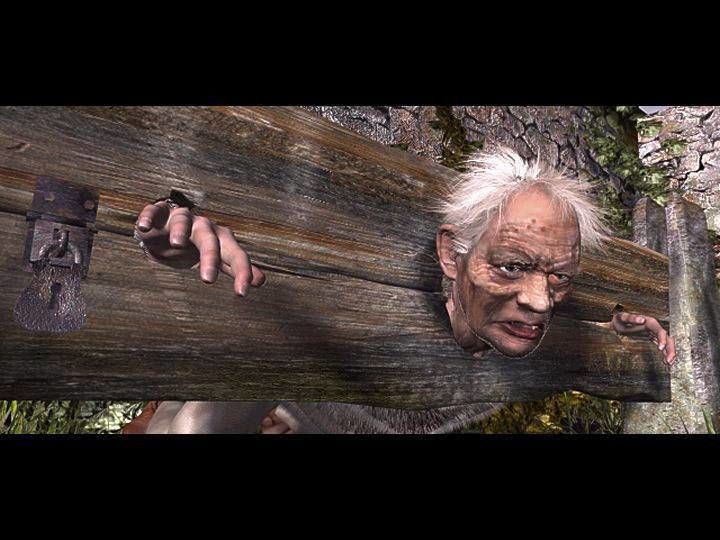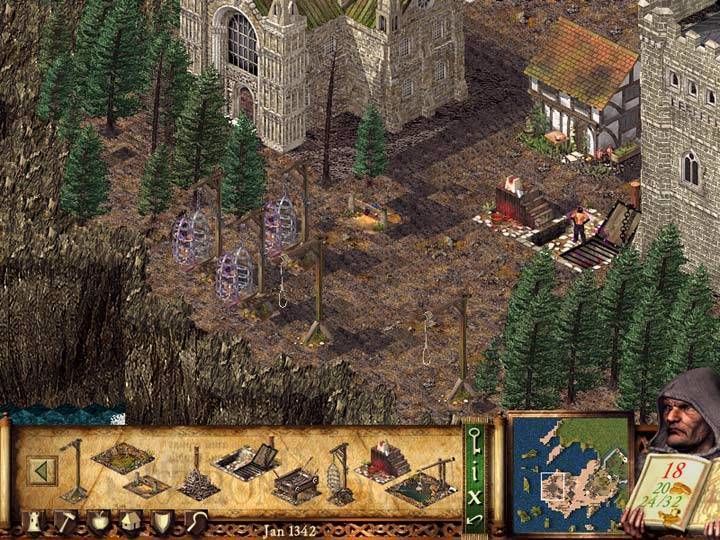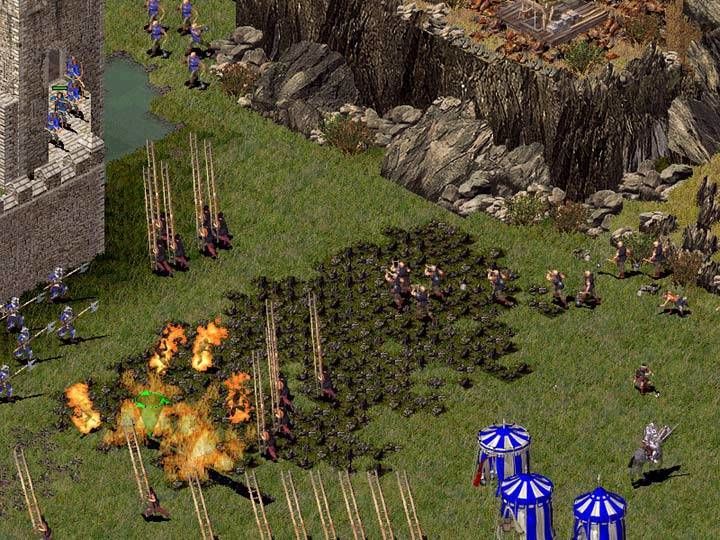There are a number of minor problems with Stronghold, the new real-time strategy from Firefly Studios/Godgames. However, these flaws don't detract from what is, overall, a thoroughly entertaining experience. This game is in no way groundbreaking, and my guess is that this sort of real-time strategy is about to be superseded (if it hasn't already) in graphics, AI, and depth of tactical play by, for instance, Commandos 2 or the next Shogun installment. Although it has even been said -- and it’s probably true -- that the AI is better in Microsoft’s two year-old Age of Empires II, Stronghold nevertheless offers a more immersive experience, without overwhelming the player with micro-management. Moreover, Stronghold goes a long way toward capturing the mood of the Middle Ages – at least, the Middle Ages as imagined from the theoretical vantage points of Romanticism and Enlightenment reason (with a dose of Monty Python and the Holy Grail and a Medieval Times theme restaurant thrown in for good measure). Idyllic communities, rife with friendly farmers, joking jesters, and prancing pikemen, clash with might-makes-right militias, whose superstitious and uneducated soldier-sadists would sooner boil a helpless peasant’s already toothless visage in oil than dance around the maypole.
Stronghold is a standard build-and-kill real-time strategy set in medieval England. Players can choose to muster mounted knights, pikemen, macemen, or warrior monks, to name a few, in their quest to vanquish their foes on the battlefield. Engineers are also available to man ballistas, catapults, and the like in the defense of a castle, or to construct battering rams and siege towers – two of the more effective offensive instruments. Ladder bearers and tunnelers also offer a couple of other means to penetrate wood or stone keeps, although actually utilizing these two units in a skirmish proved quite difficult and perplexing. As one might guess, defending a castle is much easier than attacking one, and archers and crossbowmen on the battlements do most of the real work. The designers seem to have counterbalanced this situation by bequeathing macemen and swordsmen with the ability to slowly chip away at castle walls. Unfortunately, realism of the game suffered in the process.
There are two basic types of scenarios possible: the military and the economic. Military scenarios dispense with most of the town building enterprise and allow the more bloodthirsty among us to focus completely on tactics and the intricacies of medieval siege warfare. The historically based sieges that are offered are well designed and seem realistic, although I have to admit that I know next to nothing about the actual historical engagements. Combat is as exciting as that found in Shogun, although somewhat diminished by the isometric/pseudo-3D design of the game. One can switch between only North-South-East-West perspectives to observe the scene, and there are a mere two degrees of zoom. For the overwhelming majority of play I remained close to the action and zoomed out occasionally to the rather graphically challenged view in order to turn a brief eye toward the forest and not the (beautifully rendered) trees. The rousing cheers of spearmen as they were given orders to charge into a rain of boiling oil, however, called me back to what was always a thrilling fight.
Economics based scenarios were for me just as, or even more, absorbing. The task at hand usually centers on producing enough cheese and meat for a feast or trading ale for arms in the service of a higher noble. The standard “build this to get that to build this to get that” framework operates here without any real innovations, but I could hardly contain the sheer pleasure I received watching brewers take haps from the town stockpile to their hut and stir giant vats of ale. Millers grind wheat for flour, lumberjacks chop trees and fashion wood into planks, dairy farmers lug large cheese wheels to the granary. A Stronghold town is visually rich indeed, and the activities of the peasants are meticulous and varied.
Even economically based scenarios will require at least a modest militia, however, and a barracks, a blacksmith, and other arms producing structures will spring up sooner or later to ward off angry bears, infestations of rapidly multiplying rabbits, and nihilistic local rogues with low IQ’s and compensatory growls. Unrepentant peaceniks will nevertheless find a comfortable niche with the “free build” option, in which a miniature medieval hamlet can be constructed from the ground up and seemingly without any pressures from raiding bandits or ravenous wolves. Choose this mode if you wish to recline with a mellow but engaged mind, issuing sigh after sentimental sigh as you watch simple rustics pool their efforts gleefully to build a better future.
Full economic and military campaigns are also available, with commentary by a somewhat overly serious narrator and debate among fellow nobles. After each stage of the campaign various opponents will shamefully curse your good name.
Strategically speaking, some might criticize Stronghold for being too simplistic. Keeping the people happy and well fed is crucial, but not too difficult to master in a short amount of time. Once one gets the knack, it becomes second nature and never varies. For the most part low taxes, -- and not really religion, increased rations, or ale – get the job done. (In this respect Stronghold is undeniably modern.) Nonetheless, I find that the socio-economic system is on the whole quite balanced. Not getting bogged down with tedious micromanagement allowed me to turn my attention fully to dispensing with invaders when they charged through the dell.
Outside of the aforementioned lapses in realism and the simplicity of the political model, there a few more noteworthy deficiencies in Stronghold.
STRONGHOLD VERDICT
Unfortunately, in-between mission taunts by your opponents are the only continuity between the each segment of the campaign. Completion of one battle or economic goal brings new types of military units and structure possibilities, but one must build a keep, town, and army from scratch. Stronghold would have been improved immensely if units carried over from previous conflicts, with surviving soldiers improving their proficiency as in Shogun. At the very least, the ability of the lord of the castle to influence his people’s morale could increase with each new victory. The greatest weakness of this game is that the campaign is just a succession of scenarios, each win merely coloring a division of the Risk-like map of Britain. Manipulating troop units with any significant finesse was difficult, if not impossible. The interface here is rather clunky, and I found myself frustrated when attempting to align soldiers for a neatly orchestrated offensive. Placing them defensively was a much more satisfying affair, although the AI for their patrolling leaves much to be desired. Dedicated strategists looking for a serious challenge will quickly avail themselves of the map/scenario creator option and most likely design a last-ditch fortress holdout, manned by a greatly outnumbered force. Multiplayer mode might add more interesting strategic possibilities, although my guess is that players will have to spend a significant amount of time finding the proper balance of forces.








